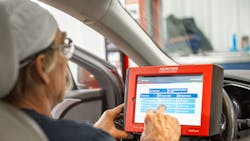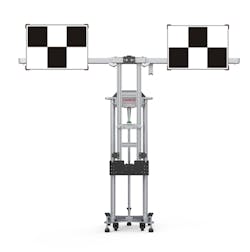As Advanced Driver Assistance Systems (ADAS) technology becomes more common in vehicles on American roadways, there’s a growing market to maintain, inspect and calibrate the many systems that fall underneath the large ADAS umbrella — blind spot detection, automatic emergency braking and lane departure warnings are just a few.
Depending on the specific technology, either a static or dynamic calibration is needed. Some require a scan tool and test drive. Others need more equipment, including target boards to ensure proper alignment.
Haresh Gobin, product development manager for LaunchTech USA, a manufacturer of ADAS equipment, says, “There are many variables that contribute to addressing ADAS calibrations across the spectrum on Euro, Asian and domestic vehicles. Each OE manufacturer has specific processes and procedures, in addition to technologies utilized in their vehicles.”
The expectation is these technologies will only continue to evolve, as they’re directly tied to making roadways safer.
New research published in August by the AAA Foundation for Traffic Safety estimated that ADAS technologies could prevent 37 million crashes, 14 million injuries and almost 250,000 deaths over the next three decades. “This would represent 16% of crashes and injuries and 22% of deaths that would otherwise occur on U.S. roads without these technologies.”
It’s imperative tire dealers become more acquainted with their service opportunities surrounding ADAS. We asked the experts who are manufacturing calibration equipment for help with some basics, from the tools and space needed to do the job, to how and when to talk to customers about ADAS.
MTD: What equipment do tire dealers need on hand to service ADAS?
Kyle Harris, product manager, Hennessy Industries Inc.: The types of equipment required to service ADAS systems on today’s vehicles will vary with vehicle manufacturer, the specific system needing service, and the actual operation being performed. For example, many new cars do not need any equipment at all to calibrate certain ADAS systems; the vehicle needs only to be taken for a short test drive. At a minimum, shops should be prepared with a modern scan tool with the latest updates.
Ryan Gerber, ADAS product specialist, Hunter Engineering Co.: Ideally, a tire dealer would already have an alignment system, which most do. Pretty much every ADAS calibration begins with an alignment, because if the wheels aren’t going straight, then neither is the ADAS. This is a big deal, because the cameras and radar work like a flashlight beam. What may be a tiny bit off near the bulb becomes way off the farther out they go, which means the ADAS can’t properly do what it’s designed to do.
Besides an aligner, a shop will need some sort of ADAS calibration system that can ideally handle a wide range of vehicles, although you don’t have to go all-in from your first calibration. It’s not really the shop or technician that “does” calibrations; it’s the software. The better your system, the greater your opportunities.
Haresh Gobin, product development manager, LaunchTech USA: To service ADAS systems the requirements vary per (vehicle) manufacturer. Some systems require dynamic calibrations which are done with the vehicle in motion/simulating a drive cycle while a professional-level scan tool is communicating with the vehicle’s control modules.
Other vehicles require a static calibration which is done (while the vehicle is) stationary in a controlled indoor environment with proper lighting, space and levelness of flooring. Static calibrations also require the use of a professional scan tool in addition to a calibration unit such as the Launch X-431 Mobile Plus that adheres to OE standards and procedures.
Other equipment requirements that tire dealers need to have access to are: TPMS diagnostic tools, alignment equipment and automotive informatics reference databases.
Frank Terlep, vice president of ADAS solutions at Auto Techcelerators, an Opus IVS company: It depends on what ADAS calibration/validation services they want to offer. I always recommend the first step for a tire dealer is to decide if they want to be in the ADAS calibration/validation business. Once they decide they do want to be in that business, the next step is to decide what ADAS services they want to offer.
The equipment a tire dealer will need will depend on the ADAS services they decide to offer. Below is a list of basic equipment a tire dealer may need to offer ADAS calibration/validation services: alignment system; lift; ADAS targeting system(s); aftermarket diagnostic tool(s), which are usually available with targets; OEM diagnostic tools or remote diagnostic service.
In addition to equipment, tire dealers will also need an invoicing and documentation system. Documentation is critical when it comes to ADAS calibration/validation services. There are repair order and repair order lines, pre- and post-repair/calibration reports, the calibration results report and post-calibration documentation from test drive results. Pre-calibration documentation includes tire pressure, images of the vehicle’s four corners, images of the dashboard with the key on and doors closed, images of the empty trunk and full tank of gas.Chris Chesney, vice president of training, Repairify Inc. dba asTech: Each shop, no matter the primary service they provide, needs to evaluate the ADAS calibrations they will most likely encounter and be responsible for. In the case of the typical tire dealer, the most common service associated with new tires is a four-wheel alignment. The effect that an alignment has on ADAS systems is dependent on the vehicle but there are some common systems to be prepared to address. The equipment needed is going to depend on the systems you need to calibrate and the vehicles you will see in your shop. If you are going to align Toyota Camrys, then you will need to be able to calibrate sensors that affect automated emergency braking (AEB), lane keep assist (LKA), etc. If you are going to align GM Silverados, you’ll need to be able to perform the dynamic calibration associated with these forward-looking sensors. The answer to what equipment tire dealers need requires some research into their car parc and services offered, along with the limitations of their facility or location.
MTD: Are there levels of ADAS service tire dealers can offer? (Certain services with a lower-dollar investment, and more advanced services with a higher-dollar investment?)
Harris (Hennessy): Dynamic calibrations for vehicles and systems that require it, is a very low investment service to offer a customer after a windshield replacement, for example. In most cases only a proper scan tool with the current updates is required.
Static calibrations typically take far more time to set up and complete with many vehicles taking as long as a few hours to perform certain procedures. Static calibrations require the most investment in equipment, floor space and labor hours to complete.
Gerber (Hunter): I wouldn’t describe it as levels; more like capabilities. Preparing yourself to do every possible calibration for every possible model would be a huge undertaking, but there’s no need to do that. Like any other procedure, you start small and work your way up as you gain experience. Begin with models you’re familiar with, learn how calibrations work, and expand from there.
Many dynamic, or driving, calibrations can be done with aftermarket scan tools. Investing in one that’s focused on ADAS calibrations is a good starting point with a low cost. When your experience justifies taking on more business — and it will — you can purchase equipment that allows you to do static calibrations with fixtures and targets.
Gobin (LaunchTech): The entry cost to fully service and accommodate ADAS on Euro, Asian and domestic vehicles is investing into a calibration unit package that comes with a variety of targets and accessories that will allow for static calibrations, in addition to a professional diagnostic scan tool.
The minimum requirement for a tire dealer would be a professional-level scan tool. In this case they will be able to only address dynamic ADAS calibrations and ADAS pre-scan reports.
Chesney (Repairify): Tire dealers will encounter forward-facing sensor calibrations more than anything. These services will include static calibrations and dynamic calibrations depending on the vehicle. For static calibrations the shop will need the OEM targets and fixtures to hold and position the target along with the factory scan tool or access to a remote service provider who uses the factory tool to activate the calibration once the target is placed.
For dynamic calibrations, the factory scan tool or a remote service provider using the factory tool is used to activate and direct the road test in a way that allows the vehicle to gather enough information to adjust the sensor properly. Prior to a dynamic road test there may be additional adjustments to the sensor mounting bracket or measurement of sensor angles that will require the use of special levels, gauges or other specific tools or fixtures. All of this information is found in OEM service information.
MTD: Does ADAS require special considerations in a facility? Size of space, environment, lighting, etc.
Harris (Hennessy): Performing static ADAS calibrations does require a significant space be available for such procedures. A dedicated 50-foot-by-40-foot space that is clear of obstructions and clutter, (and has) a level floor is ideal. It is also important that the area be well lit. Any shadows or glares that are cast on a target board, for instance, could prevent a calibration from being possible. A clean floor is also preferred, as many static procedures do require markings and reference points be marked on the floor.Gerber (Hunter): ADAS calibrations have certain guidelines and requirements that are established by the OEMs. These can vary widely, but most are feasible for almost any size shop. A certain amount of space is required, but nowhere near as much as is commonly believed. Other requirements include things like a level surface, a certain degree of lighting, an unobstructed view without nearby distractions, etc., but again, these are usually not huge obstacles.
Gobin (LaunchTech): Different manufacturers have varying space requirements. A space 40 feet by 20 feet (is) able to accomplish most ADAS front and rear calibrations. For forward-facing camera calibrations, the minimum space is 32 feet by 16 feet.
Chesney (Repairify): Every ADAS calibration, static or dynamic, has specific space, environment, floor level, floor and wall color, etc. requirements outlined in service information. Tire dealers are typically limited in space and usually have a lot of clutter such as hoists, tire racks, tire service equipment that can cause issues with radar calibrations and can distract a camera from seeing its intended target.
The most important thing to consider when evaluating your space is to view your space from the perspective of the sensors or cameras you will be calibrating. Is the space evenly lit or is there glare during the day. Are there metal columns or tire racks or equipment in the space in front of the vehicle that can cause an erroneous calibration of a forward-facing radar sensor? These scenarios can cause a faulty calibration or prevent a calibration completion.
For dynamic calibrations, is your facility located in an area that allows an appropriate road test as described in service information? The road test for a dynamic calibration is not the same for every vehicle. It is also important to know that the typical space requirements outlined by the OEMs can be a bit misleading. While they describe the space required to do any and all calibrations on their vehicles, when you are only concerned with a forward-facing sensor, the space you need to have is in front of the vehicle, not behind or in most cases beside the vehicle.
MTD: Drivers often rely on their car drifting to one side to signal they need a standard wheel alignment. How will they know an ADAS component needs alignment/calibration? How can tire dealers help educate consumers and explain the need for ADAS calibration?
Harris (Hennessy): ADAS safety systems do not require routine calibration or attention. If a warning light is present or if a system appears to not be operating properly it would be best to have it looked at by a professional. Tire dealers can communicate this to their customers by keeping an open dialogue with their customers every time they are in for service. These safety systems are important, just like tires brakes and wipers for safe vehicle operation.
Gerber (Hunter): Unless it’s a dashboard warning light, a driver would not necessarily know an ADAS component needs adjusting. They would need to rely on shops to alert them when calibrations are needed. Fortunately, this problem basically solves itself, since a calibration is usually called for any time an ADAS component is disturbed in any way, including when it’s a simple remove and replace. Many common procedures trigger a required ADAS calibration, such as a windshield replacement, bumper repairs and so forth.
Gobin (LaunchTech): Drivers will be able to know if an ADAS system needs calibration by overcompensation alerts that are not functioning correctly, in addition to warning lights that denote diagnostic trouble codes (DTCs).
Terlep (Opus IVS): The short answer is, the driver probably won’t. If an ADAS-equipped vehicle is “drifting” to one side, it may only need an alignment. It also may only need proper tire pressure in the tire. It may also be that the tires are “mis-matched.” The vehicle may also have suspension damage. It is important that the tire dealer still check for the “basics.”
Once the basics have been checked, then it is important to perform a proper test drive/drive cycle following OEM drive cycle procedures to ensure the ADAS systems operate as the OEMs state they should. If, after a proper drive cycle is performed and the vehicle’s ADAS systems are still not performing properly, a calibration should be performed.
There are many different opportunities for tire dealers to educate and explain the need for ADAS calibration/validation services. The most obvious time is when the consumer arrives at the tire business for an estimate or for service. It is our recommendation (that) one of the first steps the tire dealer takes is to identify the ADAS systems on the vehicle and then inform/educate the consumer on those systems and why and how they need to be serviced, calibrated and validated based on the service(s) the vehicle may need.
Tire dealers could utilize point of sale materials to educate consumers. If the tire dealer uses email marketing, this is a powerful tool for educating consumers. Like email marketing, social media is also a very powerful tool for educating consumers. In-shop educational ADAS clinics are another great way to “show and tell” why ADAS calibration/validation services are critically important.
Chesney (Repairify): The typical scenario at a tire dealer is when a customer purchases a new set of tires and a wheel alignment where the steering angle sensor is adjusted to zero as required when thrust angle has been adjusted. Anytime the thrust angle has been adjusted or changed, the steering angle sensor must be adjusted to zero. And anytime the steering angle sensor is adjusted, the sensors that ‘assume’ the steering angle sensor was at zero when they were last calibrated must be calibrated to the newest setting.
The argument is often made that if the last time the sensors were calibrated, and the steering and thrust angles were zero, if over time the thrust angle changed there isn’t a need to calibrate after a wheel alignment. This is a risky assumption because there is no way to know when the last calibration took place and if the proper procedures were followed. If you don’t perform the required calibrations, you risk sending your customer out in a vehicle that reacts differently than they have become accustomed to. Most motorists get used to how their vehicle performs. Not calibrating after an alignment can cause the vehicle to react differently, which the motorist may notice, but which may put them at risk when the technology is needed to avoid an accident.
It is important to spend some time with each customer to educate them about the ADAS on their vehicle. The new car dealer most likely did not show them how these systems work and certainly didn’t share how tire services can affect their accuracy if not calibrated properly. This means the tire dealer needs to educate their team to be able to have those conversations with their customers.
MTD: Is an ADAS alignment/calibration needed every time the wheels are aligned?
Harris (Hennessy): In most cases making a minor adjustment to front toe does not require a complete ADAS re-calibration. In the event of a collision or if related components are repaired or replaced, it may be required to calibrate those affected systems. With that in mind, it is always best to follow OEM recommendations on what procedures are performed and when.
Gerber (Hunter): An alignment usually precedes an ADAS calibration, since if the wheels aren’t going straight, neither is the ADAS, which is not good. But a typical wheel alignment itself will not automatically trigger a calibration unless the components are somehow disturbed, or the particular OEM requires it.
But the main thing with tire dealers is that they’re already doing alignments; hopefully as many per day as they possibly can. They may as well take the next step and begin doing calibrations as well. As they’ve likely heard, before long every vehicle on the road will have sophisticated ADAS equipment that will require periodic calibrating. There’s a huge market that’s only going to grow, and if they don’t take advantage of their opportunities, someone else surely will.
Gobin (LaunchTech): Per most OE manufacturer’s recommendations, whenever a vehicle is aligned an ADAS calibration is needed. The reason for this is due to the suspension geometry is changed and the various systems need to adjust their distance and proximity algorithms to be in sync with the new measurements. Additionally, ADAS calibrations are needed in other scenarios such as whenever any repair is done such as shock replacement, brake replacement, or suspension components.Terlep (Opus IVS): ADAS is an integral part of modern vehicles, offering features like lane departure warnings, adaptive cruise control, automatic emergency braking and more. Calibration of these systems is critical to ensuring their proper functioning, especially after certain vehicle service procedures.
Wheel alignment is one such procedure that might necessitate ADAS calibration. Misalignment can affect the ADAS sensors' ability to accurately read the vehicle's position on the road. Therefore, recalibration is often required to make sure that the systems are working correctly.
Several OEMs (at least 10) recommend or even require ADAS calibration following wheel alignment, as it's a best practice to maintain the correct functioning of these systems.
The requirements for ADAS calibration may vary between different makes and models, and even between different years of the same model. Therefore, it's always advisable to refer to the specific vehicle's service manual or consult with the manufacturer directly to understand the precise requirements for ADAS calibration after a wheel alignment.
Chesney (Repairify): I think I illustrated this above, but essentially, if the thrust angle is changed and/or steering angle sensor is adjusted, then any ADAS sensor that assumes thrust angle is zero should be calibrated.
About the Author
Madison Hartline
Associate Editor
Madison Hartline (Gehring) is the associate editor for Modern Tire Dealer and Motor Age. Since joining MTD after graduating from The Ohio State University in 2022, she has taken on the role of managing the brand’s social media strategy, producing podcast episodes and overseeing eNewsletter content.
Don't miss Hartline's next article. Sign up for MTD's newsletter.
Joy Kopcha
Managing Editor
Joy Kopcha joined Modern Tire Dealer and Auto Service Professional as senior editor in 2014 after working as a newspaper reporter for a dozen years in Kansas, Indiana and Pennsylvania. She was named managing editor of MTD and ASP in 2022, and took on that same role with Motor Age in 2024.
She is an award-winning journalist, including in 2023 when she was named a Jesse H. Neal Awards Finalist.
Don't miss any of her articles. Sign up for MTD's newsletters.





